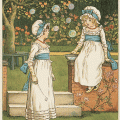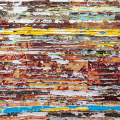Brand New: The complicity of consumerism in Reagan’s America
The 1980s—the era of big hair and bigger shoulder pads—ushered in the conspicuous consumerism of the Reagan era. The ’80s also saw the beginning of the age of AIDS and a new subversive artistic approach to consumer complicity in the racism, sexism and homophobia of popular culture.
Don’t miss the Hirshhorn’s comprehensive exhibition on excess, “Brand New: Art and Commodity in the 1980s,” closing this weekend. Bonus! Staff discount for the May 12 closing gala celebration.
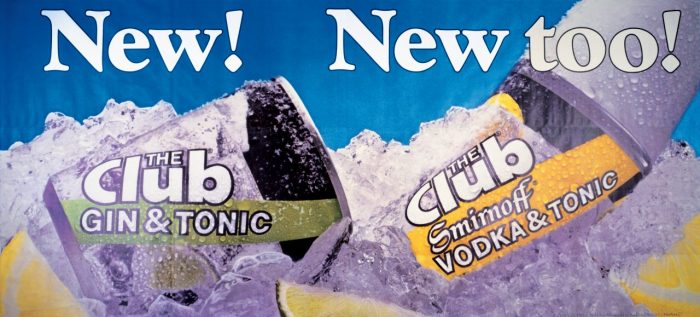
Jeff Koon, New! New too! 1983. c Jeff Koons
It is slightly overwhelming. A hot pink wall at the top of the escalator screams “Look at me!” as the echoes of Dana Birnbaum’s “Rémy/Grand Central: Planes and Trains and Boats”—operatic, folksy music punctuated with clanging train bells—mingle with the whirring of the escalator.
To the left through a doorway is Jenny Holzer’s artwork “Inflammatory Essays,” (1979-1982) a wall of rows upon rows of neon. To the right is a glimpse of Donald Moffet’s “He Kills Me” (1987) filled with orange targets and Ronald Reagan’s portrait. It’s hard to know where this exhibition begins and where it ends.
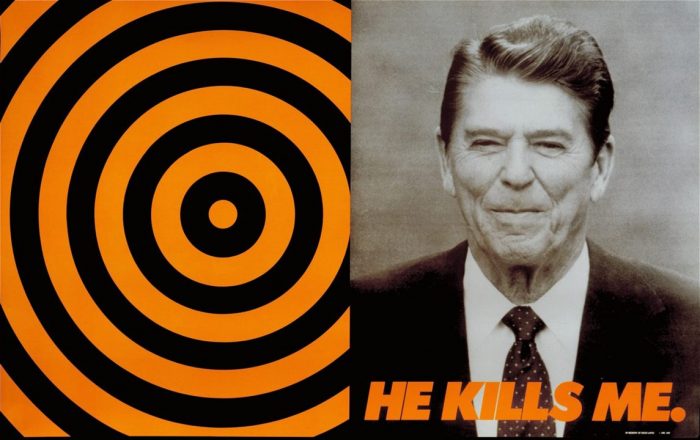
Donald Moffett, He Kills Me, 1987. International Center for Photography. Purchase, with funds from the ICP Acquisitions Committee. Courtesy of the artist and Marianne Boesky Gallery, New York and Aspen. c Donald Moffett.
The cacophony and chaos in these initial moments feel like exiting Grand Central Terminal and stepping into the bustling streets of New York City. That’s fitting, since “Brand New: Art and Commodity in the 1980s,” on view at the Smithsonian’s Hirshhorn Museum and Sculpture Garden, focuses on changes in the New York art world from 1979 to 1989.
Curator Gianni Jetzer says he always tells students, “You only get one first impression! You want to start a show with a strong atmospheric piece.” Birnbaum’s piece, which is heard before it is seen, does just that.
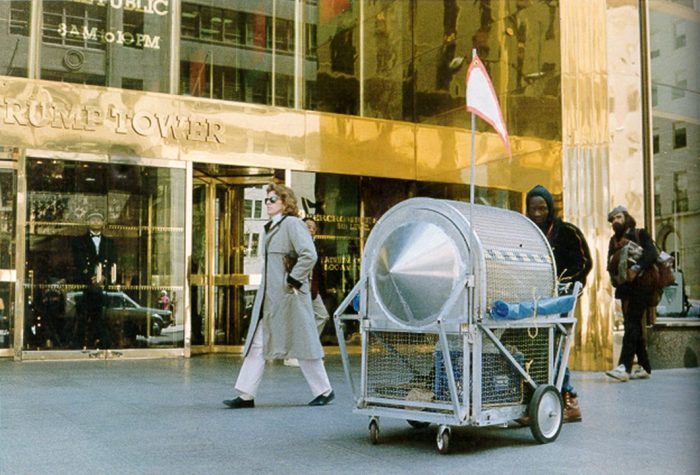
Krzysztof Wodiczko, Homeless Vehicle in New York City, 1988-1989. Hirshhorn Museum and Sculpture Garden. c Krzysztof Wodiczko, Courtesy Galerie Lelong & Co., New York
It does much more than set a mood, though. Birnbaum’s and Holzer’s works represent the frame of mind of both artists and consumers in the 1980s. They “show different approaches to commercial reality in the early ‘80s,” Jetzer says. “In some cases, you can feel the questioning of this new reality: how can you make art touching upon commercialism without losing your independence as an artist?”
Birnbaum’s piece was commissioned by Rémy Martin, the French cognac company. Part advertisement, part experimental film project, “Planes and Trains and Boats” features, Jetzer says, “a young woman who sips from a bottle of the expensive liquor as if it was Coca-Cola.”
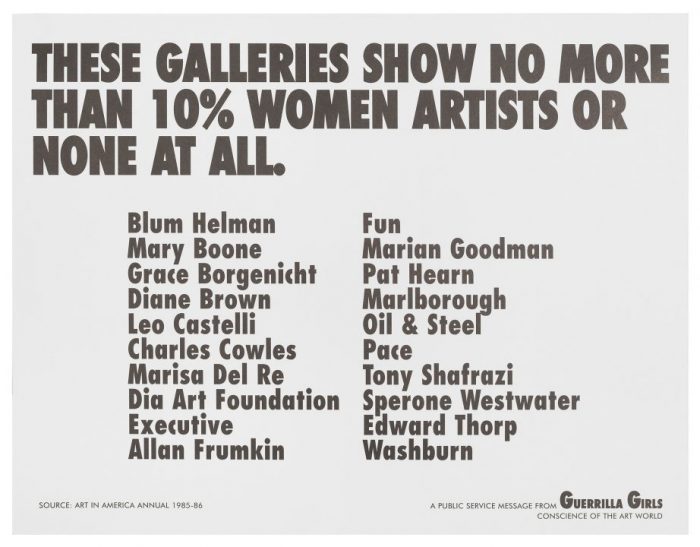
Guerilla Girls, Thes Galleries Show No More Than 10% Women Artists or None at All, 1984 – 1985, Hirshhorn Museum and Sculpture Garden, Photo by Cathy Carver
Listening to the piece from around the corner, there is no hint that it is a brandy advertisement. This kind of intentional dissonance is prevalent throughout “Brand New,” and gets at the very essence of the exhibition: Using everyday items, such as cleaning products and snack foods, to offer serious commentary about society is jarring—and all the more effective for it.
“The crossing of different aspects of reality is key for the 1980s,” Jetzer explains, and has remained integral to artists since then. “Since the ‘80s, artists have grafted many layers of reality onto their artworks. Often, political, economic, and social realities are contained in the same piece.”
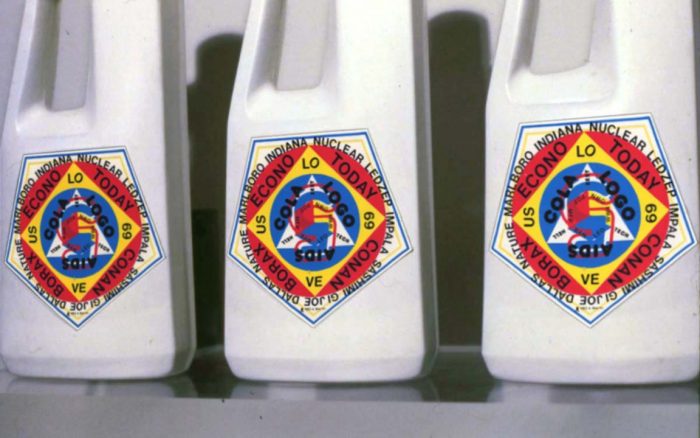
Alan Belcher, $51.49. Courtesy Alan Belcher
Alan Belcher, for example, decorated bottles of fabric softener with bright logos inspired by pop artist Robert Indiana, featuring the words LOGO, COLA, and AIDS. As wall-text explains, this provocative juxtaposition was to “underscore the complexity of the times.”
Other artists juxtaposed found objects–or images–to make a statement. Julia Wachtel took two pictures from 1980s greeting cards, one of a caricatured Native American girl and one of a stereotypical white housewife, and painted them together to show the “racist, sexist, and classist messages” conveyed in popular culture.
“I put a spotlight on how these images, which might usually be taken for granted, are not natural,” Wachtel explained in a 1983 artist’s statement. “By putting the two images of the objectified women next to each other, I was attempting to show how we are positioned as voyeurs to these images and perhaps become unconsciously complicit in our gaze.”
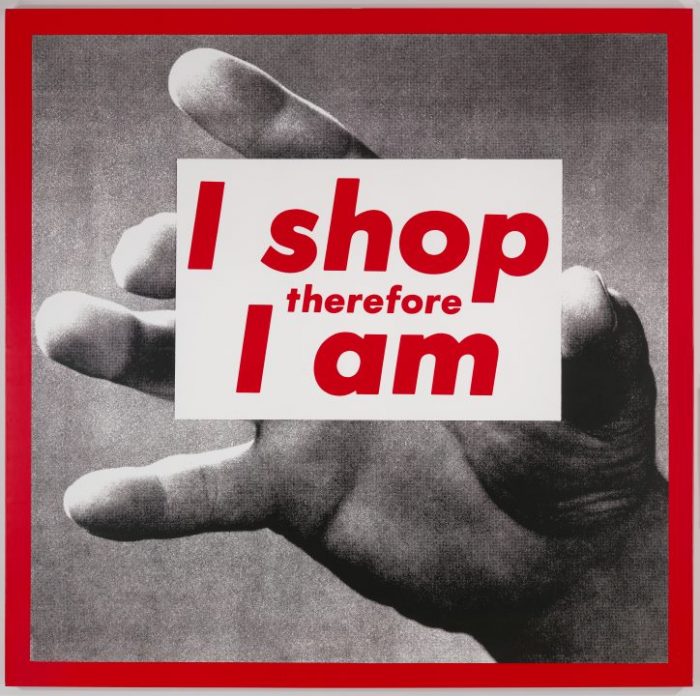
Barbara Kruger, Untitled (I shop therefore I am) 1987. Glenstone Museum, Potamac, Md, c Barbara Kruger. Courtesy Mary Boone Gallery, New York. Photo by Tim Nighschwander/Imaging4Art.com
Our complicity is made conscious through “Brand New” because the artworks make the point that advertisement is a language, one in which we are all fluent. Ads have a look, using bold colors and fonts, short words, and the mixing of graphics and photographs.
Pieces like Jeff Koons’ 1983 “New! New too!” and Barbara Kruger’s 1987 “Untitled (I shop therefore I am)” draw attention to this language, reflecting broad but no less exacting truisms about consumer culture. These artists, and especially Kruger, “addressed consumption as a form of self-expression—the idea that we eventually gain identity by buying products,” Jetzer says.
Other pieces in “Brand New” use the visual rhetoric of advertising to point out how branding and advertisements communicate more subliminally. In her “Vanilla Nightmares #8” (1986), artist Adrian Piper took an ad page from The New York Times that featured a fair-skinned model and added charcoal drawings of dark figures surrounding her. Her work drew attention to the implicit exclusivity of the perfume the image advertised, which perpetuated the “segmentation of society” and prevalent racism of the time.
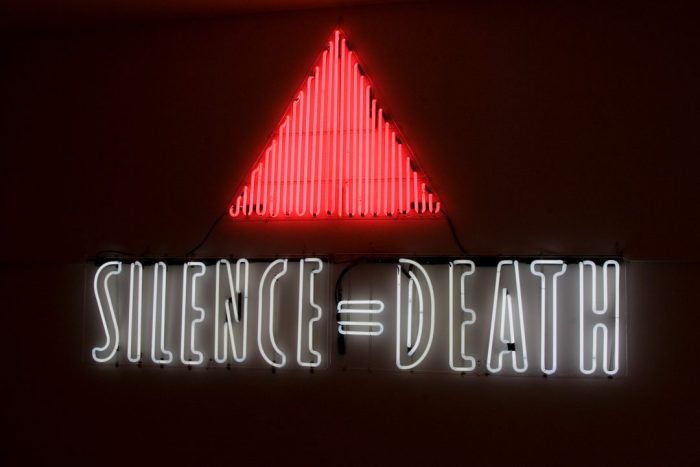
ACT UP (gran Fury), SILENCE = DEATH, 1987. Courtesy New Museum, New York, William Olander Memorial Fund
Barbara Bloom’s “Planned Abandon” is one of Jetzer’s favorite pieces in “Brand New,” because it’s one of several that the museum has “redone” for the first time in more than 30 years. The large-scale installation was shown in 1981, but not again until “Brand New” exhibited it this year. The Hirshhorn “not only shows or collects art but also has the responsibility to reconstruct works from the past and secure historical data for future generations,” Jetzer says.
The label text describes “Planned Abandon” as a “generic public information center…” Three spotlights illuminate an information table in front of a generic mural sporting palm trees and a mounted poster rack. The scene looks contrived and empty without people breathing life into it.
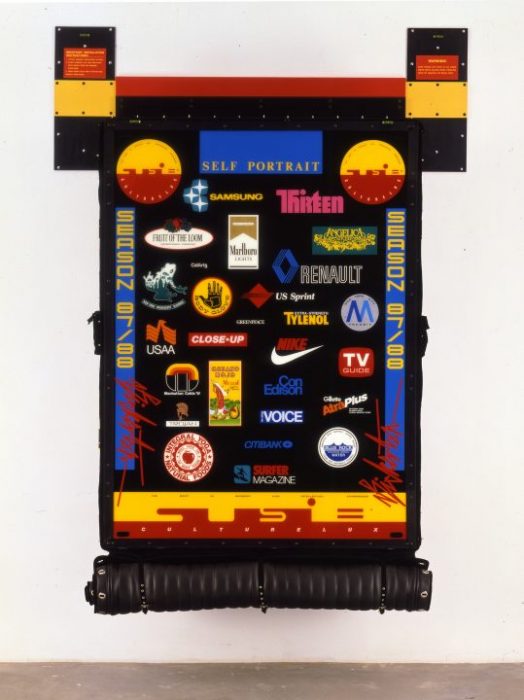
Ashley Bickerton, Tormented Self-Portrait (Susie at Arles) No. 2, 1988. Des Moines Art Center Permanent Collections; Purchased with funds from the Edmundson Art Foundation, Inc. 1994. Courtesy of the artist and Lehmann Maupin, New York and Hong Kong
Bloom created the piece soon after the 1979 Iran hostage crisis, and the space’s design is intended to “suggest a skillfully manipulated crossroads of tourism, marketing, and propaganda.”
“We worked closely with the artist to recreate wallpaper, furniture, poster rack and clocks to make it accessible to today’s public,” Jetzer says. “Interestingly, the subject of travel and terrorism threats has not lost any of its relevance.”
According to Jetzer, that’s precisely why “Brand New” is still timely. But its relevance isn’t just about the social and political parallels it bears to today. “I do not think you can understand today’s contemporary art practices without thinking about the contributions of these artists. They pushed the envelope of what conceptual art can be by triggering the communicative potential of the art object.”
“Brand New” is on view at the Hirshhorn through May 13, 2018.
Grace Aldridge Foster is a freelance writer who has written extensively about the Smithsonian for Smithsonian Insider and other publications.
You’re invited to the Hirshhorn’s closing gala bash for “Brand New: Art and Commodity in the 1980s.”
Saturday, May 12
8:30 PM
$250 Public/SI Discount $195
Use code: HIRSHHORNGALA2018
Get tickets >
Mingle with gala honoree Jeff Koons and art and culture enthusiasts from around the globe. Feel your jaw drop and your taste buds tingle with delicious, one-night-only dessert performance by artist Jennifer Rubell. Break out your best Studio 54-in-the-‘80s dancing outfit—and ogle everyone else’s. Explore the exhibition Brand New: Art and Commodity in the 1980s late into the night.
You’ll enjoy:
- Dessert performance by artist Jennifer Rubell in her first commissioned work in DC. Past installations have invited guests to smash and eat Jeff Koons-inspired chocolate bunnies, pluck dripping walls of glazed donuts, and eat their way through a padded cell of cotton candy, featured in Vogue, Vanity Fair, and The New York Times.
- Music and dancing with Gotham tastemaker and nightlife impresario DJ Jus Ske, hot off of collaborations with Jay Z, Justin Timberlake, and Pharrell
- Late-night access to Brand New: Art and Commodity in the 1980s right before it closes
Open bars with specialty 1980s-themed cocktails - ‘Lunch Box’ buffet offering a modern twist on favorite ‘80s treats—Hostess Apple Pies™, Snow Balls™, Funfetti cake, and more
- Bite-size desserts from vintage memories—Chocolate S’mores, Cookies and Cereal Milk, Neon Macaroons
- ‘Smoking Station’ cold-infusing gourmet chocolates to order
- And more . . .
Sound like fun? It will be. And all proceeds support the Hirshhorn’s groundbreaking free exhibitions and public programs.
Don’t miss out!
Posted: 8 May 2018
- Categories:

